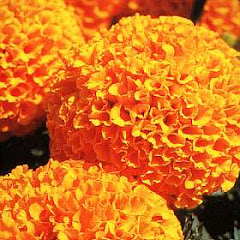
Review from the New York Times "The heroes and villains in "The Future of Food,"
Deborah Koons Garcia's sober, far-reaching polemic against genetically modified foods, are clearly identified. The good guys, acknowledged in the film's cursory final segment, are organic farmers along with a growing network of farmers' markets around the United States that constitute a grass-roots resistance to the Goliath of agribusiness and the genetically engineered products it favors. The bad guys, to whom this quietly inflammatory film devotes the bulk of its attention, are large corporations, especially the Monsanto Company, a pioneer in the development of genetically engineered agricultural products. In recent years, Monsanto has patented seeds that yield crops whose chemical structures have been modified to ward off pests.
The film poses many ticklish ethical and scientific questions:
The film's answers to these five questions are: No. Possibly damaging. Probably not. Probably not. Possibly.
In each case, the movie outlines the pluses, the minuses and the imponderables. But the overall attitude of Ms. Garcia, the widow of the Grateful Dead guitarist Jerry Garcia, might be summed up with the scolding slogan "It's not nice to fool Mother Nature."
Much of the film is devoted to Monsanto's prosecution of Canadian farmers on whose property the company discovered traces of its patented Roundup Ready canola seed, which is genetically engineered to kill pests. Though the seed had drifted accidentally onto the farmers' land, courts ruled that they had violated Monsanto's patent and were liable for damages.
The film begins with a capsule history of agriculture going back more than 12,000 years but concentrating on the 20th century. It traces the development of chemical fertilizers and pesticides, the rise and fall of the green revolution, its morphing into the gene revolution, and the implanting of natural bacterial toxins into the cells of corn. Can wheat be far behind?
In the mid-1990's, Monsanto, the DuPont Company and others bought the seed industry. Monsanto alone spent $8 billion investing in the notion that, as the film bluntly puts it, "whoever controls the seeds controls the food."
Monsanto has even developed a "suicide seed" that makes crops kill themselves after one planting. What might happen, the film wonders, if this seed mixed with wild seeds?
The movie wags its finger at the hand-in-hand relationship of multinational corporations and big government. One of the film's more unsettling revelations is its identification of the connections between Monsanto and top government officials who have been board members, consultants and executives for its subsidiaries. As a result, the movie insinuates, the government has little interest in underwriting research into the promotion of biodiversity and other alternatives to the economic goals of agribusiness.
The movie ends on a tentative upbeat note. It visits farmers' markets where the organically grown tomatoes look so inviting you want to pluck them off the screen and slice them into your own scrumptious B.L.T. We see whole-earth-style advocates carrying signs that read, "Our children are not lab rats." Goliath, we are assured, still has a way to go before trampling all the Davids armed with slingshots.
View Part1 here:
Deborah Koons Garcia's sober, far-reaching polemic against genetically modified foods, are clearly identified. The good guys, acknowledged in the film's cursory final segment, are organic farmers along with a growing network of farmers' markets around the United States that constitute a grass-roots resistance to the Goliath of agribusiness and the genetically engineered products it favors. The bad guys, to whom this quietly inflammatory film devotes the bulk of its attention, are large corporations, especially the Monsanto Company, a pioneer in the development of genetically engineered agricultural products. In recent years, Monsanto has patented seeds that yield crops whose chemical structures have been modified to ward off pests.
The film poses many ticklish ethical and scientific questions:
- Since genetic material is life, should corporations have the right to patent genes?
- What are the long-term effects on humans of consuming genetically engineered food, which is still largely unlabeled in the United States?
- Can the crossbreeding of wild and genetically modified plants be controlled?
- Might genetically engineered food be the answer to world hunger?
- And finally, could the reduction of biodiversity, which has quickened since the introduction of genetically modified plants, lead to catastrophe?
The film's answers to these five questions are: No. Possibly damaging. Probably not. Probably not. Possibly.
In each case, the movie outlines the pluses, the minuses and the imponderables. But the overall attitude of Ms. Garcia, the widow of the Grateful Dead guitarist Jerry Garcia, might be summed up with the scolding slogan "It's not nice to fool Mother Nature."
Much of the film is devoted to Monsanto's prosecution of Canadian farmers on whose property the company discovered traces of its patented Roundup Ready canola seed, which is genetically engineered to kill pests. Though the seed had drifted accidentally onto the farmers' land, courts ruled that they had violated Monsanto's patent and were liable for damages.
The film begins with a capsule history of agriculture going back more than 12,000 years but concentrating on the 20th century. It traces the development of chemical fertilizers and pesticides, the rise and fall of the green revolution, its morphing into the gene revolution, and the implanting of natural bacterial toxins into the cells of corn. Can wheat be far behind?
In the mid-1990's, Monsanto, the DuPont Company and others bought the seed industry. Monsanto alone spent $8 billion investing in the notion that, as the film bluntly puts it, "whoever controls the seeds controls the food."
Monsanto has even developed a "suicide seed" that makes crops kill themselves after one planting. What might happen, the film wonders, if this seed mixed with wild seeds?
The movie wags its finger at the hand-in-hand relationship of multinational corporations and big government. One of the film's more unsettling revelations is its identification of the connections between Monsanto and top government officials who have been board members, consultants and executives for its subsidiaries. As a result, the movie insinuates, the government has little interest in underwriting research into the promotion of biodiversity and other alternatives to the economic goals of agribusiness.
The movie ends on a tentative upbeat note. It visits farmers' markets where the organically grown tomatoes look so inviting you want to pluck them off the screen and slice them into your own scrumptious B.L.T. We see whole-earth-style advocates carrying signs that read, "Our children are not lab rats." Goliath, we are assured, still has a way to go before trampling all the Davids armed with slingshots.













No comments:
Post a Comment